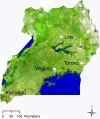Bioefficacy of long-lasting insecticidal nets against pyrethroid-resistant populations of Anopheles gambiae s.s. from different malaria transmission zones in Uganda
- PMID: 23634798
- PMCID: PMC3656772
- DOI: 10.1186/1756-3305-6-130
Bioefficacy of long-lasting insecticidal nets against pyrethroid-resistant populations of Anopheles gambiae s.s. from different malaria transmission zones in Uganda
Abstract
Background: There are major concerns over sustaining the efficacy of current malaria vector control interventions given the rapid spread of resistance, particularly to pyrethroids. This study assessed the bioefficacy of five WHO-recommended long-lasting insecticidal nets (LLINs) against pyrethroid-resistant Anopheles gambiae field populations from Uganda.
Methods: Adult An. gambiae from Lira, Tororo, Wakiso and Kanungu districts were exposed to permethrin (0.75%) or deltamethrin (0.05%) in standard WHO susceptibility tests. Cone bioassays were used to measure the bioefficacy of four mono-treated LLINs (Olyset®, Interceptor®, Netprotect® and PermaNet® 2.0) and one combination LLIN (PermaNet® 3.0) against the four mosquito populations. Wireball assays were similarly conducted to determine knockdown rates. Species composition and kdr mutation frequency were determined for a sample of mosquitoes from each population. Chemical assays confirmed that test nets fell within target dose ranges.
Results: Anopheles gambiae s.s. predominated at all four sites (86-99% of Anopheles spp.) with moderate kdr L1014S allelic frequency (0.34-0.37). Confirmed or possible resistance to both permethrin and deltamethrin was identified for all four test populations. Reduced susceptibility to standard LLINs was observed for all four populations, with mortality rates as low as 45.8% even though the nets were unused. The combination LLIN PermaNet®3.0 showed the highest overall bioefficacy against all four An. gambiae s.l. populations (98.5-100% mortality). Wireball assays provided a more sensitive indicator of comparative bioefficacy, and PermaNet 3.0 was again associated with the highest bioefficacy against all four populations (76.5-91.7% mortality after 30 mins).
Conclusions: The bioefficacy of mono-treated LLINs against pyrethroid-resistant field populations of An. gambiae varied by LLIN type and mosquito population, indicating that certain LLINs may be more suitable than others at particular sites. In contrast, the combination LLIN PermaNet 3.0 performed optimally against the four An. gambiae populations tested. The observed reduced susceptibility of malaria vectors to mono-treated LLINs is of particular concern, especially considering all nets were unused. With ongoing scale-up of insecticidal tools in the advent of increasing resistance, it is essential that those interventions with proven enhanced efficacy are given preference particularly in areas with high resistance.
Figures



References
-
- WHO. WHO World Malaria Report 2010. Geneva: World Health Organization; 2010. p. 136.
-
- D’ Alessandro U, Olaleye BO, Mcquire W, Langerock P, Bennett S, Aikins MK, Thomson MC, Cham MK, Cham BA, Greenwood BM. Mortality and morbidity from malaria in Gambian children after introduction of a treated bed nets programme. Lancet. 1995;345:479–483. doi: 10.1016/S0140-6736(95)90582-0. - DOI - PubMed
-
- Lengeler C. Insecticide-treated bed net and curtains for preventing malaria. Cochrane Database Syst Rev. 2004;2:CDOO363. - PubMed
-
- WHO. Guidelines for Laboratory and Field testing of Long-lasting Insecticidal Mosquito Nets. Geneva: World Health Organization; 2005. WHO/CDS/WHOPES/GDCPP/2005.11.
MeSH terms
Substances
LinkOut - more resources
Full Text Sources
Other Literature Sources
Miscellaneous

